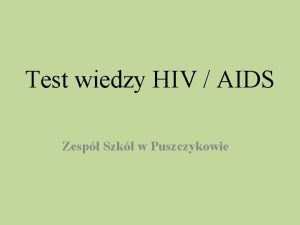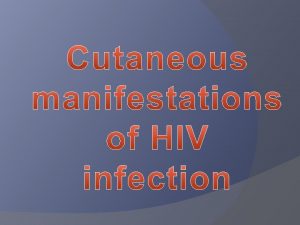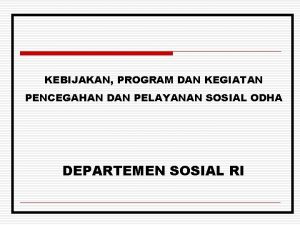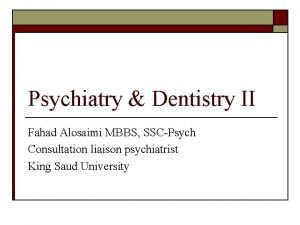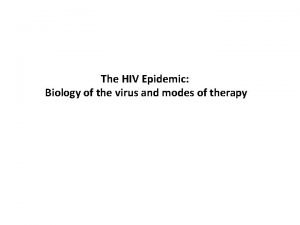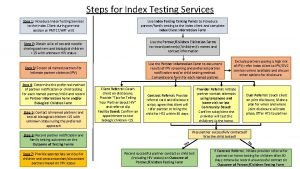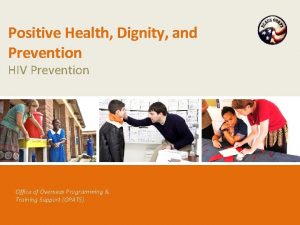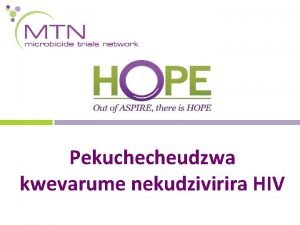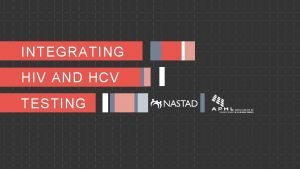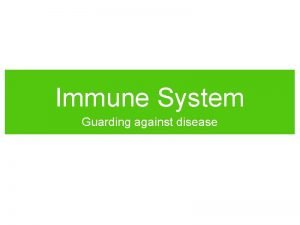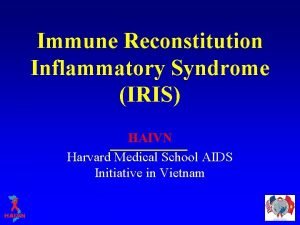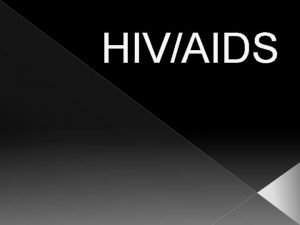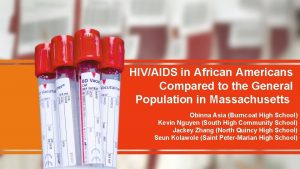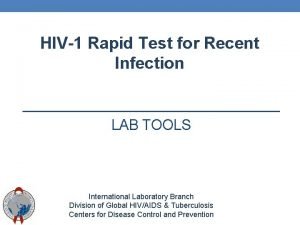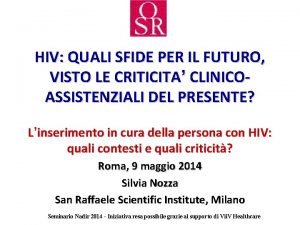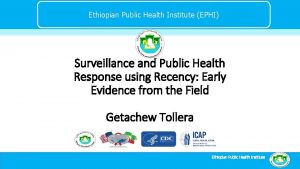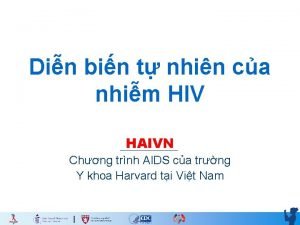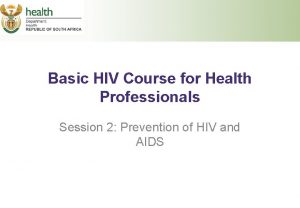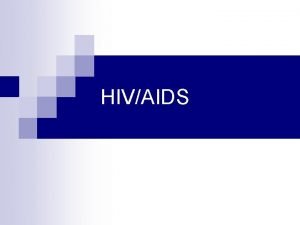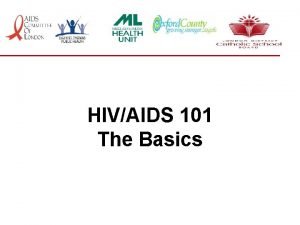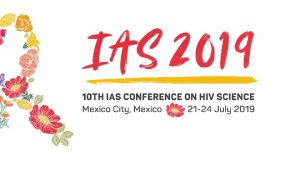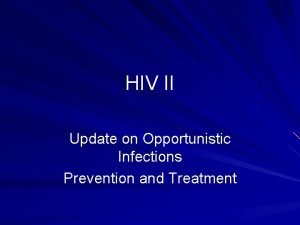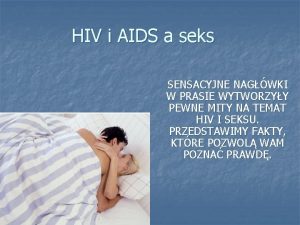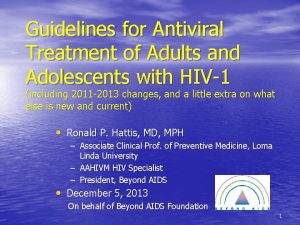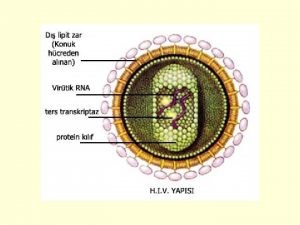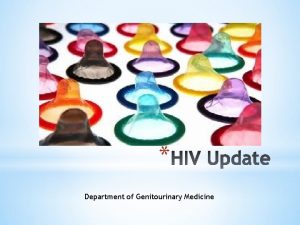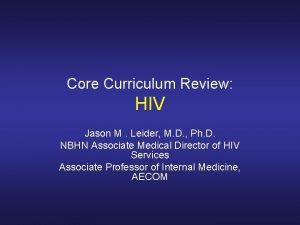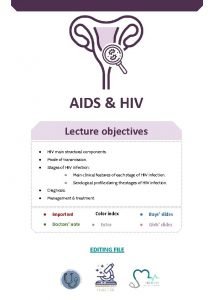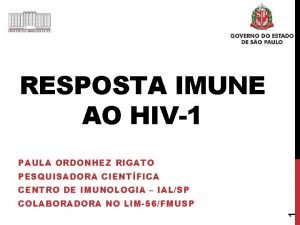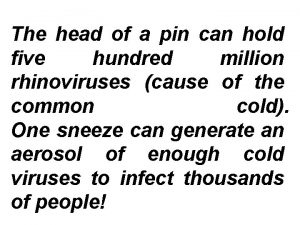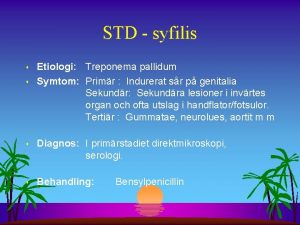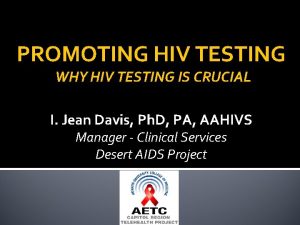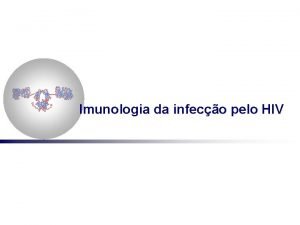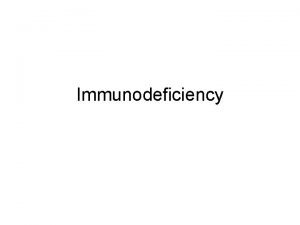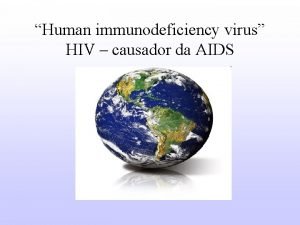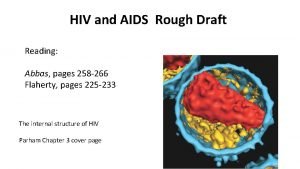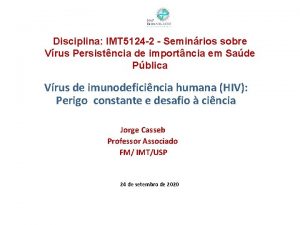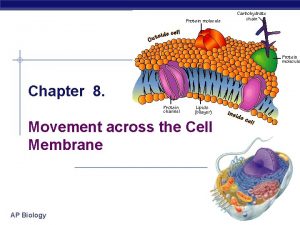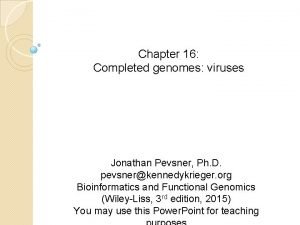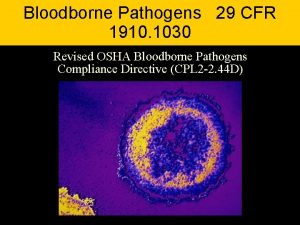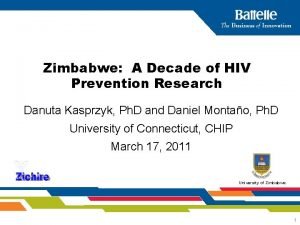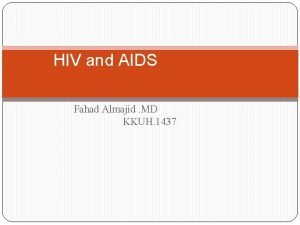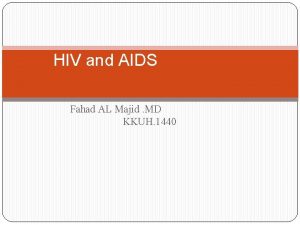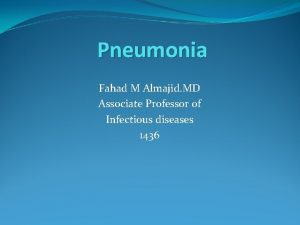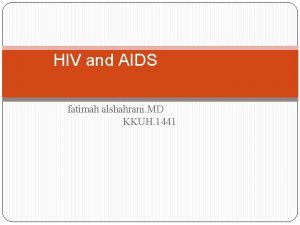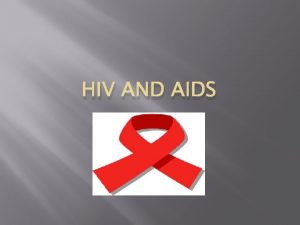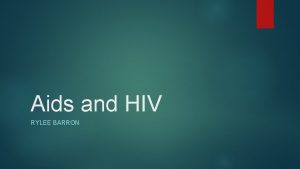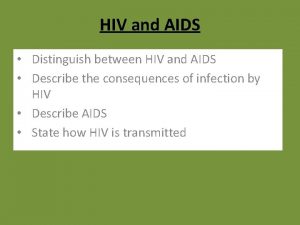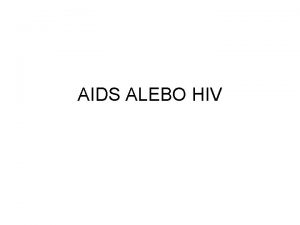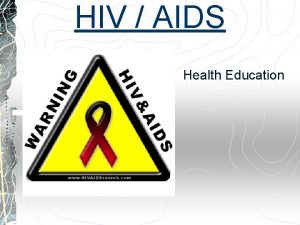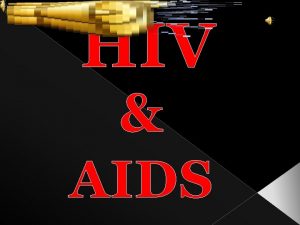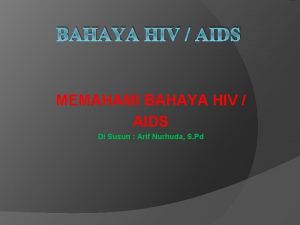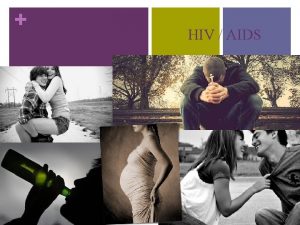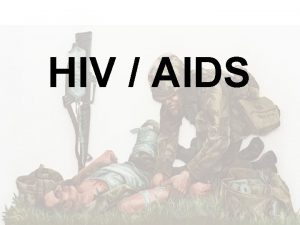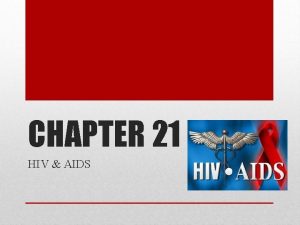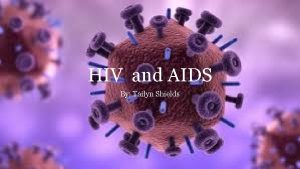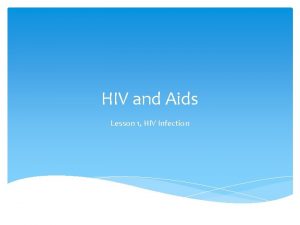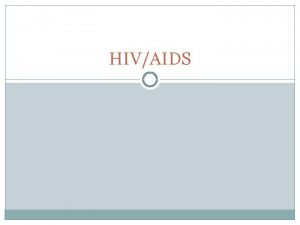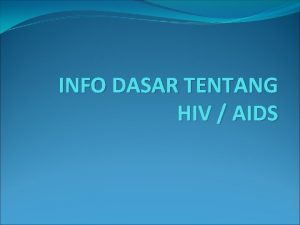HIV and AIDS Fahad almajid MD KKUH 1436












































![HIV and AIDS q Stages of HIV infections: A] Viral Transmission : The mode HIV and AIDS q Stages of HIV infections: A] Viral Transmission : The mode](https://slidetodoc.com/presentation_image_h2/0f4774567b082aefe72b789660cfd115/image-45.jpg)
![HIV and AIDS C] Seroconversion : Development of a positive HIV antibody test usually HIV and AIDS C] Seroconversion : Development of a positive HIV antibody test usually](https://slidetodoc.com/presentation_image_h2/0f4774567b082aefe72b789660cfd115/image-46.jpg)









- Slides: 55

HIV and AIDS Fahad almajid. MD KKUH. 1436

HIV and AIDS Definition: HIV Infection with Human immundefeciency Virus which leads to : Chronic and without treatment usually fatal infection characterized by : A} Progressive immundeficiency B} Long latency period C} Opportunistic infection

HIV: It is an RNA Lentivirus belong to retrovirus family. It is called “ Retrovirus “ : Retrovirus: Information in the form of RNA is transcribed into DNA in the host cell. It most likely originated from simian immunodeficiency virus.

There are two viruses HIV 1 and HIV 2. HIV 1 : Predominates world wide HIV 2 : closely resembles HIV-1 but is a much slower progression to AIDS. It predominates in Western Africa. HIV causes diseases by disrupting the immune system function as measured by CD 4 cell depletion called : AIDS Acquired Immune Deficiency Syndrome.

The hallmark of HIV Disease: Infection and viral replication within T-lymphocyte expressing the CD 4 antigen resulting in : Qualitative defect in CD 4 responsiveness Progressive depletion in CD 4 cell counts : AND This effect on helper-inducer lymphocyte will increase the risk of: 1) Opportunistic infections such as Pneumocystis Jiroveci 2) Neoplasm such as Lymphoma and Kaposi sarcoma

History 1 st recognised in USA 1981 CDC reported the occurence of : 1) Unexplained occurence of pneumocystis pneumonia in 5 healthy homosexual in LA 2) Kaposi sarcoma in 25 healthy homosexual men in NY and LA. . . later on ; 3) The disease became recognised in both male and female and Injecting Drug users as well as 4) Recipients of blood transfusion and haemophiliacs

HISTORY 1983 : HIV was isolated from patient with lymphadenopathy 1984 : HIV was demonstrated to be the causative agent of AIDS 1985 : ELISA test was developed

epidemiology HIV infection/AIDS is a global pandemic Cases reported everywhere. Ranging 30— 36 million. More than 95% reside in low and middle –income countries 50% are females 2. 5 million are children (less than 13 ) Epidemic was first recognised in USA and shortly thereafter in Western Europe. More than 2/3 rd of all people with HIV live in subsaharan africa

Asia 4. 9 million people living with HIV National HIV prevalence is highest in southeast Asia 4. 0 million HIV prevalence is decreasing in Myanamar, Cambodia and Thailand , but Increasing in Indonesia and Vietnam. Epidemic is expanding in Eastern Europe and Central Asia : 1. 6 million


Adults and children estimated to be living with HIV, by WHO Region, 2010 Europe 2. 3 million Americas 3. 0 million [2. 6 million – 3. 5 million] South-East Asia [2. 1 million – 2. 5 3. 5 million] [3. 0 million – 3. 9 million] Eastern Mediterranean 560 000 [410 000 – 790 000] Africa Western Pacific [21. 7 million – 24. 2 million] [1. 1 million – 1. 5 million] 22. 9 million Total: 34. 0 million 1. 3 million

Estimated number of adults and children newly infected with HIV, by WHO Region, 2010 Europe 190 000 Americas 170 000 [120 000 – 240 000] South-East Asia [150 000 – 230 000] 210 000 [180 000 – 260 000] Eastern Mediterranean 82 000 [54 000 – 130 000] Africa 1. 9 million [1. 7 million – 2. 1 million] Western Pacific 130 000 [88 000 – 190 000] Total: 2. 7 million [2. 4 million – 2. 9 million]

Estimated adult and child deaths from AIDS, by WHO Region, 2010 Europe 99 000 Americas 96 000 [71 000 – 120 000] South-East Asia 230 000 [84 000 – 120 000] [190 000 – 260 000] Eastern Mediterranean 38 000 [27 000 – 53 000] Africa Western Pacific [1. 1 million – 1. 4 million] [64 000 – 99 000] 1. 2 million 80 000 Total: 1. 8 million [1. 6 million – 1. 9 million]

Regional HIV and AIDS statistics and features 2010 22. 9 million Adults and children newly infected with HIV 1. 9 million [21. 6 million – 24. 1 million] [1. 7 million – 2. 1 million] Adults and children living with HIV Sub-Saharan Africa Middle East and North Africa South and South-East Asia Latin America Caribbean Eastern Europe and Central Asia Western and Central Europe North America Oceania TOTAL 5. 0% Adult & child deaths due to AIDS 1. 2 million [4. 7% – 5. 2%] [1. 1 million – 1. 4 million] Adult prevalence (15‒ 49) [%] 470 000 59 000 0. 2% 35 000 [350 000 – 570 000] [40 000 – 73 000] [0. 2% – 0. 3%] [25 000 – 42 000] 4. 0 million 270 000 0. 3% 250 000 [3. 6 million – 4. 5 million] [230 000 – 340 000] [0. 3% – 0. 3%] [210 000 – 280 000] 790 000 88 000 0. 1% 56 000 [580 000 – 1. 1 million] [48 000 – 160 000] [0. 1% – 0. 1%] [40 000 – 76 000] 1. 5 million 100 0. 4% 67 000 [1. 2 million – 1. 7 million] [73 000 – 140 000] [0. 3% – 0. 5%] [45 000 – 92 000] 200 000 12 000 0. 9% 9000 [170 000 – 220 000] [9400 – 17 000] [0. 8% – 1. 0%] [6900 – 12 000] 1. 5 million 160 000 0. 9% 90 000 [1. 3 million – 1. 7 million] [110 000 – 200 000] [0. 8% – 1. 1%] [74 000 – 110 000] 840 000 30 000 0. 2% 9900 [770 000 – 930 000] [22 000 – 39 000] [0. 2% – 0. 2%] [8900 – 11 000] 1. 3 million 58 000 0. 6% 20 000 [1. 0 million – 1. 9 million] [24 000 – 130 000] [0. 5% – 0. 9%] [16 000 – 27 000] 54 000 3300 0. 3% 1600 [48 000 – 62 000] [2400 – 4200] [0. 2% – 0. 3%] [1200 – 2000] 34. 0 million 2. 7 million 0. 8% 1. 8 million [31. 6 million – 35. 2 million] [2. 4 million – 2. 9 million] [0. 8% - 0. 8%] [1. 6 million – 1. 9 million] The ranges around the estimates in this table define the boundaries within which the actual numbers lie, based on the best available information.

Saudi Statistics Saudi Arabia remains a low-HIV-prevalence country, with approximately 1. 5 newly detected HIV infections per 100, 000 per year among Saudi nationals, and 1. 2 per 10, 000 among non. Saudis. Between 1984 and December 2013, a total of 20, 539 HIV cases were reported, of which 5, 890 (28. 7%) were Saudi citizens, and 14, 649 (71. 3%) were foreigners. Most of these non-Saudis were workers who were tested for iqama, (34%); or foreigners who were suspected HIV cases (23%), or prisoners (17%). These populations get more opportunities for testing, unlike Saudi-nationals. Therefore, the incidence in Saudis can be expected to be significantly higher among vulnerable subsets of the population. In general, reported infections will underestimate true infections.

Saudi Data In 2013 a total of 313, 352 Saudi Nationals had pre- marital HIV screening which contributed by 14 percent for the newly detected HIV cases in that year. HIV epidemic in Saudi Arabia is predominantly male, with a male-to-female ratio of 5: 1 in 2013 (445 males vs. 97 females). Data from among nationals and non-nationals suggest predominance of heterosexual transmission. Data from the largest drug detoxification centers in Riyadh, Jeddah and Damam shows 20 cases were HIV positive out of 571 Intravenous Drug Users in 2013.

• HIV is a fragile virus. It cannot live for very long outside the body • HIV is primarily found in the blood, semen, or vaginal fluid of an infected person 12/06 e AIDS Epidemic Update December 2006

HIV and AIDS Transmission Sexual (heterosexual , men who have sex with men (MSM) and others) Heterosexual is the most common mode of transmission worldwide. Vertical transmission from pregnant woman to the newborn (MTCT) is the main mode of infection in children. Blood and body fluid. Injecting Drug Use. No evidence of spread by : casual contact or by insects such as by mosquito

Structure of the virus It is an RNA virus It is an icosahedral structure of : 1) Lipid Envelope (env) derived from infected cell, containing numerous external spikes formed by two major enveloe protiens : a) The external gp 120 b) The transmembrane gp 41 2) Nucleocapsid (gag) with P 24 major core protien. The core contains two single strands of RNA. 3) Polymerase (pol)

HIV life cycle & replication 1) Attachment of VIRAL gp 120 protein to CD 4 receptor containing cells T cell, macrophages, and microglial cells : CD 4 ---pg 120 then gp 120 and gp 41 bind to the chemokines : CCXR 5 and CXCR 4 2) Fusion between cell membrane and the virion.

Life Cycle 2) Penetration 3) Upcoating 4) Reverse transcription Formation of c. DNA 4) Integration 5) Transcription of proviral DNA a) formation of genomic RNA b) formation of structural m. RNA

HIV life cycle & replication 6) Translation of structural m. RNA a) Formation of viral structural protein b) Packaging of genomic RNA of structural protein 7) Final assembly a) insertion of viral specific glycoprotein into plasma membrane b) Budding c) Release of mature virions 8) Final maturation By cleavage of gag and pol by polymerase enzyme

HIV life cycle & replication

HIV life cycle

Pathogenesis HIV infection

pathophysiology Early stage: Massive replication of the virus in the lymphatic tissues Chronic immune system activation determine the course of the illness. Permanent viral reservoirs containing proviral DNA are established in the latent T cell or macrophages.

DIAGNOSIS 1984: Rapid develpment of screening test 1985: Blood donors were routinely screened for antibody 1996: Blood banks added the p 24 antigen capture assay to detect early cases.

HIV and AIDS Diagnosis: ELISA: is the screening test , used to screen blood products and patients. Combo test : will detect HIV 1 and HIV 2 and P 24 antigen. Sensitivity of more than 99. 5% The fourth generation test: EIA test : combine detection of antibody to HIV and detection of p 24 antigen. Extremely sensitive but specificity is not optimal

Testing Confirmation : The INNO-LIA™ HIV I/II Score is a Line Immuno Assay (LIA®), to confirm : The presence of antibodies against the human immunodeficiency virus type (HIV-1) and (HIV-2) in human serum or plasma. Also differentiates between HIV-1 and HIV-2 Sensitivity 100%; Specificity 96%

Confirmatory Testing Western Blot test: It might miss the cases in EARLY stage especially since this is the most contagious period in all of HIV infection. There is a problem with the indeterminate cases. ( Window period).

Diagnosis PCR: (polymerase chain reaction) for quantitative RNA assay and used as : 1) Confirmatory test for undetermined cases. 2) To asses the viral load. 3) Babies born to HIV-positive mothers, because their blood contains their mother's HIV antibodies for several months. 4) Blood supplies Not for routine testing: a) Decreased sensitivity and specificity at lower viral load b) Significant cost.

Algorithm testing for HIV

HIV Progression

WHO staging Primary HIV infection Asymptomatic Acute retroviral syndrome Clinical stage 1 Asymptomatic Persistent generalized lymphadenopathy

HIV and AIDS Immunological staging: CD 4 positive T lymphocytes level is the main method of assessing the immune status of the HIV positive patient. 1. >500 cells/mm³ normal immunity. 2. 350 -500 cells/mm³ mild deficiency. 3. 200 -350 cells/mm³ moderate immune deficiency. 4. <200 cells/mm³ severe immune deficiency

Infections in relation to CD 4+ cell count 400 Herpes Zoster Tuberculosis 300 Oral Candidiasis 200 100 50 PCP A I D S Esophageal Candidiasis Mucocutaneous herpes Toxoplasmosis Cryptococcosis MAC CMV PML Cryptosporiodiosis Time

Clinical presentation Acute HIV infection: From exposure to symptoms: 2 -4 wks. It resembles infectious mononucleosis with : Fever, Pharyngitis, Adenopathy Rash, myalgia, fatigue, oral ulcer GIT symptoms: diarrhoea, anorexia. Result: 1) Massive response with evolution of HIV-specific immunity (CD 8 -cytotoxic T lymphocyte. )

Clinical Presentation 2)HIV RNA level falls and the symptoms resolve. CD 4 cell count rebounds but remains below the baseline.

Chronic HIV infection Asymptomatic chronic phase: Active viral replication is ongoing and progressive. Patient with high HIV RNA may progress to symptomatic disease than those with low HIV RNA level. Chronic immune activation leads to increase in various inflammatory markers. This increases the risk of Non-Aids related comorbidities: Cardiovascular, Renal dysfunction

Clinical manifestation Physical examination: Skin: condition associated with HIV Seborrheic dermatitis, Oropharynx: 1) oral trush 2) hairy leukoplakia 3) mucosal kaposis sarcoma Lymph node: Generalized lymphadenopathy (TB , Lymphoma). Eyes: Fundoscopy : CMV retinitis ( CD 4 less than 50 ). Genital exam: ulcers, condylomatous lesions , women for discharge and cervical lesions.

ORAL TRUSH

oral Trush Leukoplakia Oral Hairy

KAPOSI SARCOMA

HIV and AIDS Natural history : The average time from acquisition of HIV to an AIDS - defining illness : Is about 10 yrs…then survival averages 1 -2 yrs……. . BUT There is tremendous individual variability in these time intervals: Patients progress from acute HIV infection to death within 1 -2 yrs……and others Not manifesting HIV- related immunosuppression for 20 yrs
![HIV and AIDS q Stages of HIV infections A Viral Transmission The mode HIV and AIDS q Stages of HIV infections: A] Viral Transmission : The mode](https://slidetodoc.com/presentation_image_h2/0f4774567b082aefe72b789660cfd115/image-45.jpg)
HIV and AIDS q Stages of HIV infections: A] Viral Transmission : The mode of transmission does not affect the natural history of HIV disease. B] Acute HIV infection : Acute HIV occurs 1 -4 wks after transmission and accompanied by Burst HIV replication with a decline in CD 4 cell count. Most patient manifest a symptomatic mononucleosis likesyndrome which is usually overlooked.
![HIV and AIDS C Seroconversion Development of a positive HIV antibody test usually HIV and AIDS C] Seroconversion : Development of a positive HIV antibody test usually](https://slidetodoc.com/presentation_image_h2/0f4774567b082aefe72b789660cfd115/image-46.jpg)
HIV and AIDS C] Seroconversion : Development of a positive HIV antibody test usually occurs within 4 wks and invariably by 6 months. D] Asymptomatic HIV infection It lasts variable amount of time ( average 8 -10 yrs) and is accompanied by a gradual decline in CD 4 counts with relatively stable HIV RNA level ( the viral ‘set point’ )

Goals of Antiretroviral Therapy (ART) Eradication of HIV? Not possible with currently available antiretroviral medications. So no permanent cure. However, we can control HIV infection very well.

Goals of Therapy & Tools to Achieve Goals Improvement of quality of life Reduction of HIV-related morbidity and mortality Restoration and/or preservation of immunologic function Maximal and durable suppression of viral load

HIV life cycle RTIs Fusion inhibitors Integrase inhibitors PIs

Current ARV Medications NRTI PI Integrase Inhibitor § Abacavir (ABC) § Didanosine (dd. I) § Emtricitabine (FTC) § Lamivudine (3 TC) § Stavudine (d 4 T) § Tenofovir (TDF) § Zidovudine (AZT) § Atazanavir (ATV) § Darunavir (DRV) § Fosamprenavir (FPV) § Indinavir (IDV) § Lopinavir (LPV) § Nelfinavir (NFV) § Ritonavir (RTV) § Saquinavir (SQV) § Tipranavir (TPV) § Raltegravir (RAL) § Elvitegravir (EVG) § Dolutegravir (DTG) NNRTI § Delavirdine (DLV) § Efavirenz (EFV) § Etravirine (ETR) § Nevirapine (NVP) § Rilpivirine (RPV) Fusion Inhibitor § Enfuvirtide (ENF, T-20) CCR 5 Antagonist § Maraviroc (MVC) 26 medications, but we use only about ½ of them usually www. aidsetc. org

Treatment Indication of initiation of antiretroviral drugs chronic infection a) Symptomatic disease. b) Asymptomatic disease with 1) CD 4 count less than 350 2) pregnancy post exposure prophylaxis.

Prevention The only absolute way to prevent sexual transmission of HIV infection is Abstinence from sexual relation completely Safer sexual contact : Use of condom. . . 10% failure rate. Circumcision : results in 50% reduction of HIV acquisition Stop using IDUs Screen all blood and blood products

prevention The corner stone of an HIV prevention strategy is : Education Counseling Behaviour modification If more than 25% of infected patient does not know. What to do ? Routine testing between 13 and 64 years (CDC recommendation without written consent)

Pregnancy and HIV infection Pregnant women infected with HIV infection caries risk to infect her baby by: 1) In utero. . . 25 -40% 2) Intrapartum. . . 60 -75% 3) Breast feeding : 1) Established infection 14% 2) Primary infection 29% Current evidence suggests most transmission occur during the intrapartum period. Overall risk for mother to child transmission (MTCT) is 16 - 25 % ( without anti-retroviral Rx)

Perinatal hiv transmission Today the risk of perinatal transmission is : Less than 2% with : ü Effective antiretroviral therapy (ART) ü Elective caesarean section when appropiate ü Formula feeding
 A bacterial std that usually affects mucous membranes
A bacterial std that usually affects mucous membranes Chapter 24 sexually transmitted diseases and hiv/aids
Chapter 24 sexually transmitted diseases and hiv/aids Test wiedzy o aids z odpowiedziami
Test wiedzy o aids z odpowiedziami Causative organism of hiv/aids
Causative organism of hiv/aids Oral pathology
Oral pathology Kasus hiv aids
Kasus hiv aids Difference between psychosis and neurosis
Difference between psychosis and neurosis Fahad subhi muhammad
Fahad subhi muhammad Quang trung
Quang trung Where did hiv come from
Where did hiv come from Approche index testing
Approche index testing Prognas akreditasi terbaru
Prognas akreditasi terbaru Phdp in hiv
Phdp in hiv Chii chinonzi hiv
Chii chinonzi hiv Hiv test window period
Hiv test window period Why do the bodys antibodies fail to protect people from hiv
Why do the bodys antibodies fail to protect people from hiv Iris hiv
Iris hiv Hiv
Hiv Hiv risk factors
Hiv risk factors Asante hiv-1 rapid recency assay
Asante hiv-1 rapid recency assay Fiebig hiv
Fiebig hiv Ephi ethiopia
Ephi ethiopia Triệu chứng nhiễm hiv
Triệu chứng nhiễm hiv Basic hiv course
Basic hiv course Stakeholders in hiv prevention
Stakeholders in hiv prevention Hiv treatments
Hiv treatments What does hiv stand
What does hiv stand Aids 101
Aids 101 Hiv test window period
Hiv test window period Hiv stool color
Hiv stool color Procentowe ryzyko zakażenia hiv
Procentowe ryzyko zakażenia hiv Hiv adalah
Hiv adalah Hiv lifecycle
Hiv lifecycle 4.jenerasyon vidas hıv duo ultra testi güvenilir mi
4.jenerasyon vidas hıv duo ultra testi güvenilir mi Hiv lifecycle
Hiv lifecycle Hiv
Hiv Incubation period of hiv
Incubation period of hiv Ciclo replicativo
Ciclo replicativo Vidas hiv duo ultra package insert
Vidas hiv duo ultra package insert Profilaksis pasca pajanan hiv
Profilaksis pasca pajanan hiv Igéje szól igéje hív
Igéje szól igéje hív Hiv patologia
Hiv patologia Cytomegalavirus
Cytomegalavirus Hiv siv
Hiv siv Herpes syntom
Herpes syntom Burkitt lymphoma
Burkitt lymphoma Negative hiv test result
Negative hiv test result Hiv
Hiv Hiv
Hiv Hiv
Hiv Hiv life cycle
Hiv life cycle Ciclo do hiv
Ciclo do hiv Phagocytosis ap bio
Phagocytosis ap bio Hiv siv
Hiv siv Hiv stays alive in dried blood
Hiv stays alive in dried blood Nsradio
Nsradio


